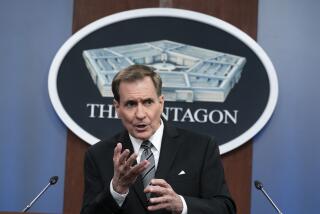GI Most Likely Killed by U.S.
- Share via
WASHINGTON — A military investigation is expected to conclude that the first U.S. soldier killed in the largest battle in Afghanistan died as a result of “friendly fire” from an Air Force gunship, a senior Pentagon official said Tuesday.
The official, speaking on condition of anonymity, said a draft report on the incident blames the deaths of Army Chief Warrant Officer Stanley L. Harriman and three Afghan fighters on fire from an AC-130 that had been circling over a mountainous region near the city of Gardez where Osama bin Laden had reportedly hidden.
Harriman’s death March 2 was originally blamed on enemy mortar fire that pounded his convoy as it moved into position under a barrage so intense that it sent the Americans’ Afghan allies into retreat. He was the first of eight Americans killed during the opening weekend of Operation Anaconda, the deadliest battle for U.S. troops.
Army Gen. Tommy Franks, who directs the war in Afghanistan as head of the U.S. Central Command, confirmed the existence of a draft report but told a Pentagon briefing Tuesday that he had not read it. He said the report was being edited to delete classified information on the methods used by special operations troops operating the gunships.
The investigation of the incident began after commanders picked up simultaneous radio reports, one of a soldier gunned down -- ostensibly by enemy mortar fire -- and a second of the gunship pilot reporting an attack on suspected Al Qaeda fighters, a second senior defense official said.
Senior Air Force officials said they were surprised at the investigation’s findings, first reported by the New York Times. If confirmed, the incident would mark the fourth American death by friendly fire since the war began Oct. 7, 2001.
Three Army Green Berets and at least two dozen allied Afghan fighters died Dec. 5 when an American B-52 bomber mistakenly dropped a 2,000-pound satellite-guided bomb on them as they fought pro-Taliban soldiers. Defense officials later concluded that an American serviceman who had called for an airstrike relayed the wrong numbers, giving his own position instead of the enemy’s.
Four allied Canadian soldiers were killed in April when two U.S. F-16 pilots violated procedures and one overrode an order to hold his fire, an investigation found.
In addition, five Green Berets and Air Force special operations soldiers were wounded and several Afghan allies were killed in a strike by a Navy F/A-18 after a member of the crew confused the coordinates of the target and friendly troops.
Green Berets in Afghanistan say the AC-130, whose low-flying rumble increases as it approaches the ground to strafe enemy soldiers, was among the weapons most feared by Taliban soldiers.
The heavily armed planes can loiter at relatively low speeds and include side-mounted 105-millimeter Howitzers that spray withering fire over a broad area. They have sensors that allow them to visually or electronically identify friendly ground forces. It remains unclear whether the equipment properly located Harriman, 34, of Wade, N.C., who should have been identifiable by tape on his helmet.
More to Read
Sign up for Essential California
The most important California stories and recommendations in your inbox every morning.
You may occasionally receive promotional content from the Los Angeles Times.













